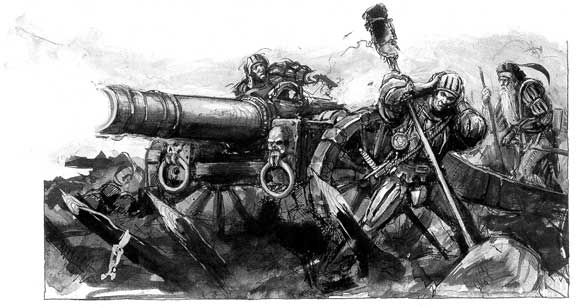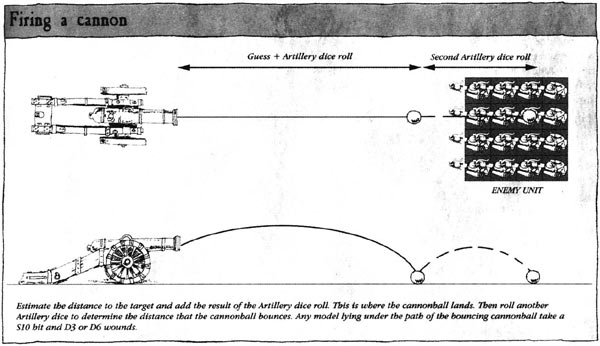Cannons are dangerous, if sometimes unpredictable, weapons whose manufacture is limited to human and Dwarf experts. When they work, cannons can shatter the most determined enemy, pouring deadly shot into his massed formations, levelling his cities and toppling huge monsters. But cannons often go wrong. Weaknesses in the casting methods can leave minute cracks or other deficiencies which cause them to explode when fired, or gunpowder can fail to ignite or may explode prematurely. Despite the occasional spectacular accident, cannons are extremely potent weapons that have been instrumental in winning more than one battle on behalf of their users. 
Cannons are fired in the Shooting phase along with any other missile weapons. To fire a cannon, it must first be turned on the spot so it points in the direction of the intended target. Then the player must declare how far the cannon is going to shoot - eg, 24", 30", 32", etc. The cannonball travels the distance that the player has nominated, plus the score from the Artillery dice. Roll this dice and add the score to the distance that has been declared. The cannonball travels the total distance towards the target and will either land short, pass straight over, or hit depending on how accurately the player guessed the range and what effect the dice has. Remember the dice will always add at least 2" to an estimate, and can add up to 10", so you should aim a few inches short of the target. Once it is established where the cannonball hits, place a small coin or other marker directly over the spot. The cannonball does not stop where it hits the ground but bounces straight forward and cuts a line through any targets in the way. To determine how far the cannonball bounces, roll the Artillery dice again and mark the spot where the cannonball comes to land. Any models between the points where the ball strikes the ground and where it eventually comes to land are hit by the flying cannonball. This line is considered to be a template for rules purposes (such as 'Look out, Sir!' rolls). When a cannonball collides through a unit, only one model per rank is hit. The diagram below shows how this works.  Any model struck by a cannonball takes a Strength 10 hit resolved in the normal manner. If the cannonball wounds its target then it causes not 1 wound but D3 or D6 wounds depending on the size of the cannon. As most models have only 1 Wound anyway it will not be necessary to roll this extra dice, but it is important when it comes to rolling for Heroes, big monsters, and engines of war which can take several wounds. Wounds caused by cannon shot cannot be saved by armour. If a cannonball hits a model which has several parts then resolve which part of the model is hit just like shooting with bows, etc. No armour saving throw is permitted for wounds caused by cannons. If a cannonball hits you, no amount of armour is going to do you any good. Ward saves can be taken as normal. For example: A cannon is fired at a unit of Goblins that is in front of the player. He makes his guess and declares that he is aiming 12" directly towards the middle of the Goblin unit. Having made his guess the player then rolls the Artillery dice and scores a 4, which equals 4". This makes a total of 16". He measures 16" towards the Goblins and places a marker where the ball hits. If he has guessed well this will be just in front of them. The ball now bounces forward the score of the second Artillery dice roll. This time he rolls an 8 and the ball bounces 8" straight through the Goblin unit hitting all the models in the way. Instead of firing a normal shot, cannon crew can declare at the beginning of the Shooting phase that they are going to use grapeshot. In that case, place the Flame template straight in front of the gun. All models under the template (even if only grazed by it) suffer a Strength 4 hit (1 wound, -2 save modifier). The Artillery dice is rolled twice when a cannon is fired, so there are two chances of rolling a Misfire result. However, the two results will be different. If a Misfire result is rolled on the first dice, the cannon has literally misfired and may explode. If a Misfire is rolled on the Bounce roll then this merely indicates that the ball has stuck in the ground and does not bounce. If a Misfire is rolled as the cannon is shot then consult the Misfire chart below.
If you roll a Misfire on your Bounce roll then the cannon is unharmed, the misfire result merely indicates that the cannon ball has stuck in the ground where it hits. If the shot lands on top of a model then that particular model is hit as normal, but there is no further bounce damage. Cannons are hand forged by master craftsmen, and each is different with little standardisation in the way of calibres or length. Individual cannons can be huge, but most are either large cannons, such as the Empire Great Cannon, or smaller cannons. Details are given below for typical examples. The difference between the two types is range and damage. Bigger cannons carry a larger charge and so have a longer range and cause more damage.
Cannons are cast from iron or bronze and are built into solid carriages. They are very difficult to destroy, although the enemy may try to attack them with other war machines, large monsters or magic, for example. Therefore they have a profile with a Toughness value and number of Wounds which they can sustain before they are destroyed. As with other details these may vary, but the typical cannons have a value shown here. The Move rate is the speed that the cannon can be moved by a full crew, assuming that the cannon's carriage has wheels. A cannon which does not have wheels cannot be moved. If any crew are slain, the cannon's speed is reduced proportionally. A cannon cannot move and shoot in the same turn except to turn to face its target. Cannons have such a long range it is pointless moving them. A cannon requires a full crew to work properly - to carry cannonballs, load gunpowder, push the machine round to bear on its target, and so on. If one crewman is slain then the rest can just about get by without reducing the rate of fire. If two or more crewmen are slain then the remaining crew will be unable to cope, so when it shoots the cannon must miss a whole turn before it can shoot again. This is in addition to any penalty imposed by a Misfire result. Obviously the cannon requires at least one crewman to work it, so the machine becomes useless should they all be slain.
Work out the effect of hits normally. Models have no armour saving throw for a cannon hit. |
|||||||||||||||||||||||||||||||||